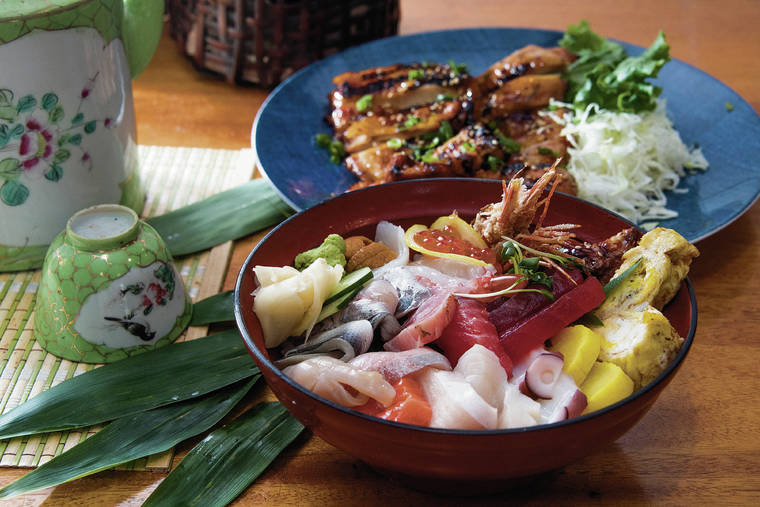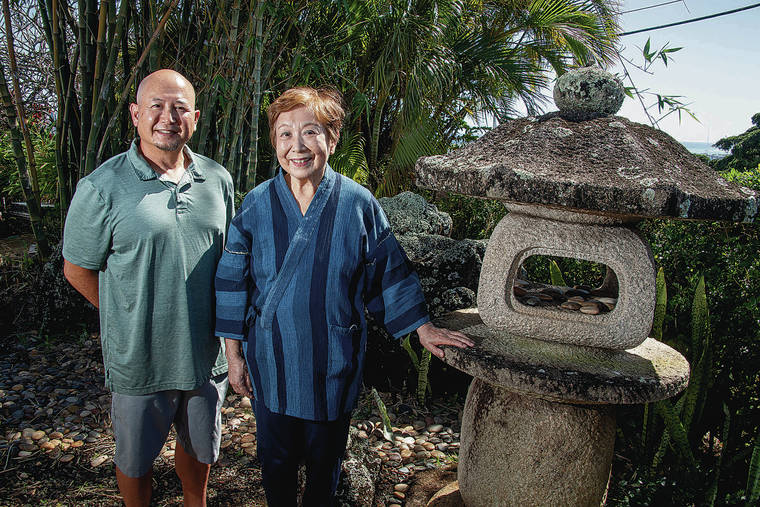Natsunoya Tea House celebrates 100 years in Alewa Heights under same family ownership


CRAIG T. KOJIMA / CKOJIMA@STARADVERTISER.COM
Chirashi, foreground, and hibachi chicken from Natsunoya Tea House, Japanese classic Japanese that has been a popular special occasion site for generations of families. It is celebrating its 100th year in 2021.

CRAIG T. KOJIMA / CKOJIMA@STARADVERTISER.COM
Emiko Fujiwara now helps her son Laurence Jr. with the tea house. The stone lantern on the restaurant grounds was bought from Japan by Laurence Jr.’s grandmother, Tameyo Fujiwara.



Tourists and celebrities from both sides of the Pacific — and even an international spy — have been regular customers at what is now called Natsunoya Tea House. But mostly, the landmark has been known since 1921 for its Japanese food, whether hosting or catering parties for generations of local families.
This was already the case 25 years ago when Laurence Fujiwara Jr. had a big decision to make. His father had died. Would the grandson of the man who built the place give up a more secure job to continue the family legacy?
“I didn’t feel pressure to do it, but when I talked to my wife (Kym), she said if I didn’t I might regret it,” Laurence Jr. said last week.
The two-story restaurant, nestled among residences in Alewa Heights, celebrates its 100th birthday this year.
IT WASN’T always called Natsunoya Tea House, but the business has remained in the family since Fujiwara’s grandparents, Shuichi and Taneyo, opened it as Shunchoro Tea House in 1921.
Shuichi had lost a restaurant to the 1906 San Francisco earthquake and was on his way back to Japan when he fell in love with Hawaii, and scraped up enough money to buy the land where Natsunoya stands now. He did much of the building himself. The hilly area was so remote he had to develop his own infrastructure, including utility lines and an access road.
Don't miss out on what's happening!
Stay in touch with breaking news, as it happens, conveniently in your email inbox. It's FREE!
Part of the payoff was a spectacular view of much of Oahu’s south shore.
In the early days, guests were mostly Japanese expatriates. Gradually, tourists from the U.S. mainland discovered the tea house, said Emiko Fujiwara, Laurence Sr.’s widow and Junior’s mom.
Laurence Sr. had his own tea house on School Street, called Natsunoya, but after Shuichi died in 1956, he took over his father’s larger establishment. (The original Natsunoya was closed due to the construction of the H-1 freeway.)
“Dad’s business was about 50-50, Japanese and Americans,” Laurence Jr. said. “Now it’s about 99% local.”
Over the decades, some of the Japanese tradition has gone by the wayside. Regular chairs and tables have replaced tatami (Japanese mats). But some practices remain: Footwear must be removed before entering dining rooms, and servers wear kimono.
“I think wearing the kimono helps to preserve the authenticity of the tea house, which is important since we’re the last remaining one on the island,” said server Madisen Oshiro, 20, of Kaneohe. “It’s a special opportunity to work at a place with so much history.”
THE MENU continues to focus on a wide variety of Japanese favorites, now “with a local flair,” Laurence Jr. said. Of course tea is served, but he doesn’t remember Natsunoya ever hosting a traditional tea ceremony. Several local special-occasion restaurants of the same era bore the “tea house” label.
“It’s just part of our name,” he said. “We’re more about banquets and catering.”
That was before COVID-19 hit. Natsunoya was forced to adapt, offering takeout for the first time.
“Before, it was always big batches, not made to order. We’re getting more efficient at it,” Laurence Jr. said. “I gotta be optimistic. I view it as a challenge. You take it any other way, you’re gonna lose faith. If you cannot adapt, you’re gonna get gobbled up. It’s always been that way, COVID made it more so.”
Employees are being brought back as business slowly returns, and the staff is at 33 from its peak of around 45 pre-pandemic; business is down 65% from what it was before the virus hit, he said.
“We’re gradually coming back,” general manager Sandra Nakagaki said.
The family and the tea house staff have always endured, so why not now? This business opened on the heels of the flu pandemic of 1919 that killed more than 2,000 Hawaii residents. It survived the Great Depression and World War II, when the government confiscated the business because the owner was Japanese.
While the restaurant was closed, Laurence Sr. was a federal construction worker at Pearl Harbor. Laurence Jr. said the tea house remained a gathering place for local Japanese folks.
“My understanding, from my grandmother, is that they had few other places they were allowed to go,” Laurence Jr. said.
It took a while for the business to regain its footing after the war; Laurence Sr.’s brother, Dr. Thomas Fujiwara, had been allowed to work, and brought the business back into the family.
Eventually it thrived, and celebrities from Japan and the U.S. became regular customers, Emiko said. John Wayne even filmed a scene for a movie there.
SOME REAL-LIFE drama played out at the tea house in 1941. It centered on the telescope on the second-floor lanai that is free for customers to use.
In March, a Japanese spy, Takeo Yoshikawa, posed as consulate employee Todashi Morimura and became a regular customer. Unbeknown to the Fujiwaras — or anyone else other than one Japanese handler — Yoshikawa/Morimura used the telescope to chart ship movements in and out of Honolulu Harbor. He made it back to Japan before anyone knew what he was up to, Emiko said.
Another incident, worthy of a “Magnum P.I.” or “Hawaii Five-0” script, occurred in 2005. A police car chase ended with a suspect running through the tea house’s garden before police apprehended him. Customers were forced to temporarily evacuate.
Laurence Jr. had a part-time job at the tea house while in high school during the early 1980s, but never seriously considered making it a career before his father died.
“When I took over the place really showed its age,” he said. “I’d spend the morning painting, then working on the roof until it was time to come down and start cooking.”
Laurence Jr. and Kym have four children, Mykah, Mikayla, Maiya and Mallory. Will the family legacy continue?
“We don’t ever mention the idea of taking over to them,” their father said. “That has to come from them. We want them to burn their own trail, to do what they want to do.”
Whatever happens, Laurence Jr. hopes Natsunoya Tea House exists another 100 years.
“When I see all these local landmarks closing, that’s kind of sad. Hawaii is about the local businesses and the local people.”
NATSUNOYA DINING
Natsunoya Tea House never completely closed last year, but like all restaurants it had to adjust to COVID-19 and the accompanying restrictions. In this case, it was a pretty drastic shift, as the restaurant specialized in banquets and parties, and catering for as many as 11,000 people.
“That’s what our kitchen was set up for,” owner Laurence Fujiwara Jr. said.
With no catering and no sit-down service allowed for a time last year, Natsunoya has added made-to-order plate lunches and bentos made daily.
Plate lunches range from $15 (tempura or tonkatsu) to $22 (butterfish). The bento includes a combination of garlic chicken, hibachi chicken, grilled salmon, fried aji and grilled pork, for $8 or $10.
Natsunoya is also home to Happy Hearts Mochi, which sells a variety of handmade mochi treats.
Natsunoya Tea House is at 1935 Makanani Drive in Alewa Heights; call 595-4488. Open Wednesdays to Saturdays for lunch 11 a.m. to 1:30 p.m, dinner 4 to 7 p.m.; lunch only on Tuesdays; closed Sundays and Mondays. Go to natsunoyahawaii.com Opens in a new tab for menus, including specials and pre-orders, and for reservations and catering information.



